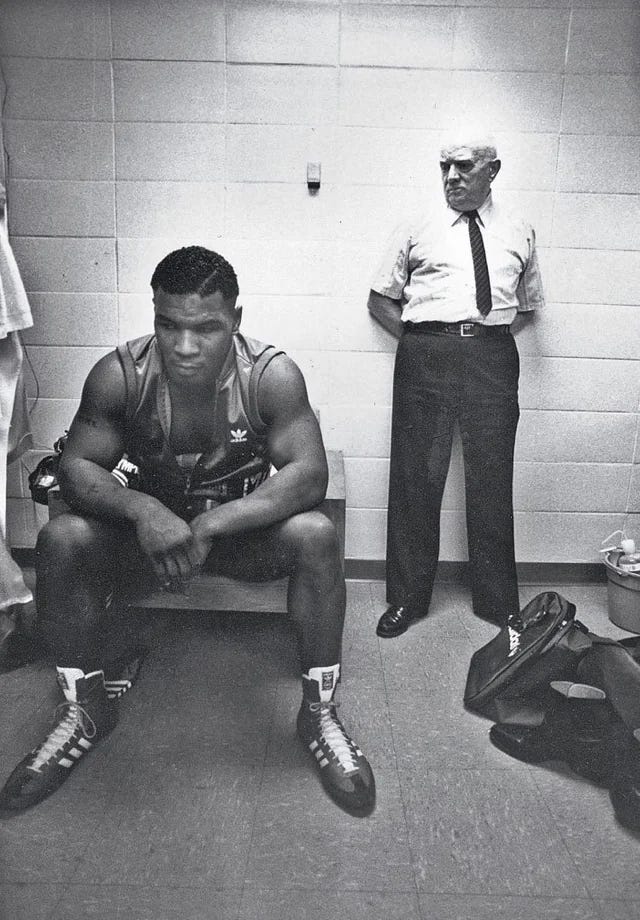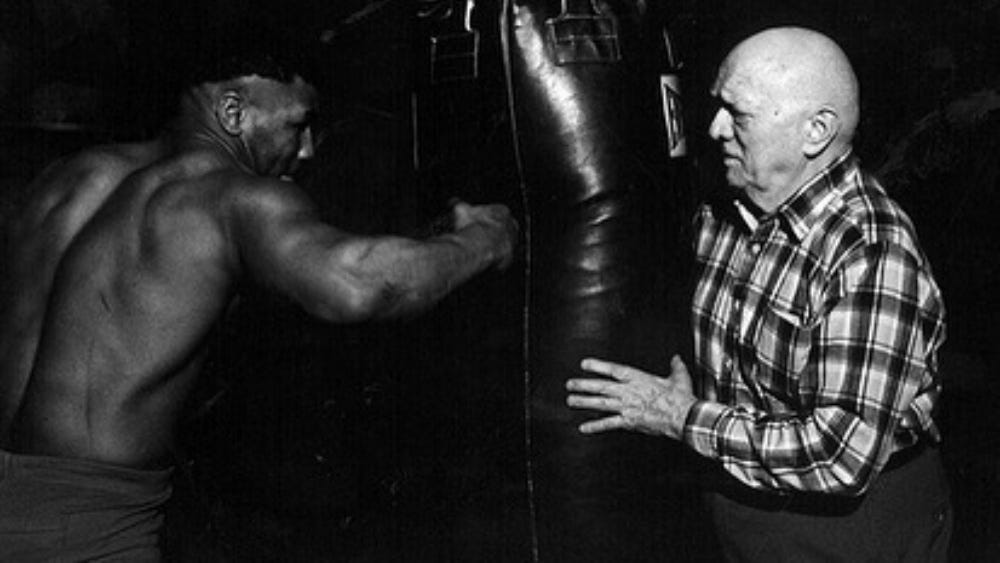“Success is not the result of spontaneous combustion. You must see yourself on fire”
18 year old Mike Tyson and his trainer Cus D’Amato just before Tyson’s first professional fight in 1985 (Albany, New York)
Today in Students of Leadership we talk about the only possible mindset for monster performance: when you have to deliver, nobody cares about what you want, need or feel; only the highest quality outcome counts. This is what high performance looks like, the rest are excuses.
Now picture a young boy growing up in a very rough neighborhood. This boy is Mike Tyson and central to his journey is a powerful mantra instilled in him by a coach and mentor, a father figure, Cus D’Amato: “You don’t exist, only the task.”
Mike’s transformational journey began when he met Cus D'Amato, a legendary boxing trainer who saw immense potential in the troubled boy. D’Amato didn’t just teach Tyson how to throw punches; he helped him shape the mindset of a titan.
Tyson learned that boxing was not just a sport, but a test of character, discipline, and focus.
D’Amato taught Tyson to visualize his opponents as tasks to be mastered, not as threats. He would often say, “You must learn to live in the moment. When you step into that ring, it’s not about you; it’s about the fight.” This philosophy became the cornerstone of Tyson’s training, pushing through pain, doubts, and distractions, to master his skills with a single-minded focus, to conquer the task.
D’Amato’s influence instilled in him a fierce sense of purpose, transforming him into a champion who understood deeply that strength lies in the commitment and ability to prioritize the task at hand over oneself. Tyson’s dedication culminated in him becoming the youngest heavyweight champion in history, a testament to the power of focus, resilience, and mentorship.
Cus D'Amato taught Mike Tyson that true greatness is not measured by winning over competitors, but by transcending one's own limitations and personal desires. D’Amato took the spark of potential within a young boxer and methodically cultivated it, turning from a flickering flame to a roaring blaze of unstoppable determination. Perhaps the biggest fear that D’Amato shared with his young mentee was that witnessing a fighter defeated by their own mind was the ultimate tragedy.
“I was a young boy, and he spoke to me every night about discipline and character”
Relentless Task Obsession
The Amazon case
You may agree or disagree with their culture, that’s not the point; Amazon philosophy exemplifies Cus D’Amato boxing philosophy.
The global tech and retail powerhouse’s leadership culture centers on an unrelenting focus on the mission and the task at hand, which fueled Amazon’s rise from an online bookstore to a company that has redefined entire industries, such as e-commerce and cloud computing.
Leaders across sectors can draw profound lessons from Amazon’s disciplined approach to execution, operational mastery, and high-velocity decision-making.
Task Over Ego
Jeff Bezos and his leadership team hard-wired the “customer first” mentality into the company’s DNA through Amazon’s famous Leadership Principles. For example, “Customer Obsession” is the first principle for a reason, it demands that every decision start with what’s best for the customer, not what’s politically expedient, good against competition or personally beneficial. The“Ownership”principle declares that leaders must act on behalf of the entire company and“never say ‘that’s not my job’.”
Importantly, Amazon cultivates leader humility as a strategic asset. The Leadership Principles include blunt reminders that no one is above critique: “Leaders are vocally self-critical, even when doing so is awkward or embarrassing. Nobody gets to rest on their laurels or act infallible. The moment you think you’ve mastered it, you stop growing.
Amazon’s leaders keep everyone’s focus on what needs improvement rather than on who gets credit.
Perhaps the clearest expression of Amazon’s task-first culture is the principle “Dive Deep.” Leaders at Amazon are expected to “operate at all levels” and that “no task is beneath them.” This is not just rhetoric, it’s common to see senior Amazon executives rolling up their sleeves to inspect details, audit data, or even spend time on the frontline. Former Amazon senior executive Jeff Wilke recalls “Understanding the entire business and process details, that’s totally the Amazon style.” When leaders model this behavior, it sends a powerful message across the organization: the mission is what matters, and everyone’s job is to do whatever it takes (within ethical and quality bounds) to execute that mission.
Disciplined Execution and Operational Mastery at Scale
Amazon’s astonishing operational prowess is the result of a disciplined and obsessive approach to execution. Just as a championship boxer drills fundamentals every day, Amazon refines its processes relentlessly. In 1999, Bezos hired the above mentioned Jeff Wilke, an MIT-trained engineer with a background in manufacturing to instill world-class process discipline in Amazon’s retail operations, so he treated Amazon’s warehouses not as retail warehouses but factories applying lean manufacturing and Six Sigma principles. In four years the results were dramatic: by 2003, Amazon had redesigned workflows and software so that any customer order could be picked, packed, and shipped in just two-and-a-half hours on average, which enabled Amazon to offer customers unprecedented speed, laying the groundwork for Amazon Prime’s two-day delivery promise, today often next-day or same-day delivery actually.
How does a company achieve this level of operational mastery? Amazon’s leaders set exceedingly high standards and never relent. Another Amazon principle is “Insist on the Highest Standards,” which in practice means never settling for “good enough.”
One famous practice is the “two-pizza team” rule, which keeps teams small enough to be fed by two pizzas, a deliberate organizational design to maintain agility and accountability. Small teams mean that every individual’s contribution to the task is visible and essential, forcing the focus on getting things done over status meetings or corporate politics.
Amazon’s meeting culture is engineered for task focus. Jeff Bezos banned PowerPoint in favor of narrative memos; at the start of key meetings, everyone sits in 30 minutes of silent reading to absorb a carefully prepared six-page memo before discussion. This ritual ensures undivided attention to the issue at hand, the content of the memo, without distraction or unnecessary talk. On top, having to write a full narrative forces clear thinking rather than top line headlines with bullet points. Also, the memo practice strips away the flashy presentations and replaces it with deep focus on the task to identify problems and solutions, as simple as that.
High-Velocity Decisions: “Day 1” Mentality, No Room for Ego
One of Amazon’s most celebrated cultural tenets is the “Day 1” mentality. Bezos used to often sign shareholder letters with “It’s still Day 1,” a reminder that the company must retain the hunger, agility, and focus of a startup, no matter how large it gets
The Day 1 mentality means never becoming complacent and never letting the organization slip into bureaucratic “Day 2,” which he famously warned is “stasis, followed by irrelevance.
Fast and effective decisions are critical to maintaining momentum so Amazon developed a framework to avoid analysis-paralysis and ego-driven debates that drag on. Decisions are of two type, Type 1 (big, irreversible choices that demand careful deliberation) and Type 2 (smaller, reversible choices that should be made quickly). He observed that as companies grow, there’s a tendency to apply heavyweight Type 1 processes to everything, resulting in slowness and excessive risk aversion. For type 2 decisions, most should probably be made with around 70% of the information you wish you had. If you wait for 90%, you’re probably being slow.
“Have Backbone; Disagree and Commit.” It’s better to be effective than to be right.
If the group chooses a path that wasn’t your idea, you move on and focus on making that plan succeed for the sake of the task.
Leadership Behaviors and Policies Reinforcing “Only the Task Exists” at Amazon
Amazon’s culture is reinforced daily by intentional leadership behaviors and company policies. Here a few concrete examples:
Obsessive Customer Focus at the Top: Jeff Bezos famously keeps an empty chair in important meetings to represent the customer’s voice, a reminder that the ultimate “boss” is the customer, not any executive’s agenda. He even reads customer complaint emails sent to his public address and will forward them to teams with a one-character reply: “?”. A “question-mark” email from Bezos is legendary inside Amazon – it means drop everything and investigate this issue. No customer pain point is too small, no detail too trivial.
“Working Backwards” and Clarity: Amazon utilizes a “working backwards” product development process. Teams start by writing an imagined press release and the FAQ for the finished product before anything is ever done to create that product. This creates extreme clarity on the task (what problem are we solving for the customer, what success looks like, how do we measure it). Every proposal must stand on its merit to the customer.
Recognition of Team Wins, Not Individual Showboating: In line with keeping egos in check, Amazon often celebrates group achievements and uses data to show which teams improved customer metrics or efficiency. Storytelling internally focuses on innovations or operational milestones rather than personal hero stories. This doesn’t mean individuals are ignored, but by spotlighting collective effort and craft excellence, you deter the culture of “rockstars” who put themselves above the team or the task.
Final Thoughts - Leadership Lessons for “Only the task exists” Mindset
Establish a “Mission-First” Mindset
Clearly define and constantly communicate a purpose that is larger than any individual and make that mission the north star in every decision. Tie goals, narratives and metrics back to this mission relentlessly.
Model Humility and Craft Mastery: Lead by example
Show that no task is beneath you. Dive into the technical details or frontline realities regularly to stay connected with the work itself and encourage leaders at every level to be “vocally self-critical” by admitting mistakes, inviting feedback, and showing that learning matters more than saving face. It has to be all about improving the work rather than protecting egos.
Install High Disciplined Mechanisms
Design processes that enforce focus and quality by adopting rigorous project docs (instead of endless slide decks), requiring data-driven justifications for proposals, or setting up small, empowered teams for faster execution on most critical projects. At the same time implement mechanisms for accountability with regular operational metrics reviews so that everyone how “the task” is progressing. However, make these reviews problem-solving moments, not finger pointing, blame excercises. By ensuring accountability you institutionalize the idea of excellence as a system, not an accident or a heroic effort.
Empower Decentralized Decision-Making
Teach your organization to differentiate big irreversible decisions from smaller reversible ones. Push authority downward and outward for Type 2 decisions to keep speed by training teams to make calls with ~70% information and iterate, instead of waiting for perfect clarity. Instill the principle of “disagree and commit” by encouraging healthy debate and expecting unified execution. You want a proactive problem solving organization operating equally at all levels.
Reward Mastery and Mission Alignment
Align incentives and recognition with the behaviors you want. Praise teams who exemplify collaboration, high standards, innovation and results that matter to the customer.
Maintain a Day 1 Culture:
No matter your team’s size or legacy, guard against complacency. Reinforce urgency and curiosity. Encourage teams to view setbacks as learning to remind themselves to stay hungry. Create a culture that sees every day as a fresh chance to excel will naturally keep people focused on what they need to accomplish, not what they’ve already done.
"Execution becomes excellence when you master it, push it to the limit and make it the heartbeat of your organization."
Robin Sharma
P.S. Before I go, here you have “The Treat,” where I share some of the music that made me company while writing … Enjoy as you bid farewell to this post
“Lead yourself, Learn to live. Lead others, Learn to Build.”
If you enjoyed reading this post consider subscribing to the newsletter for free, joining the community and sharing your thoughts.




